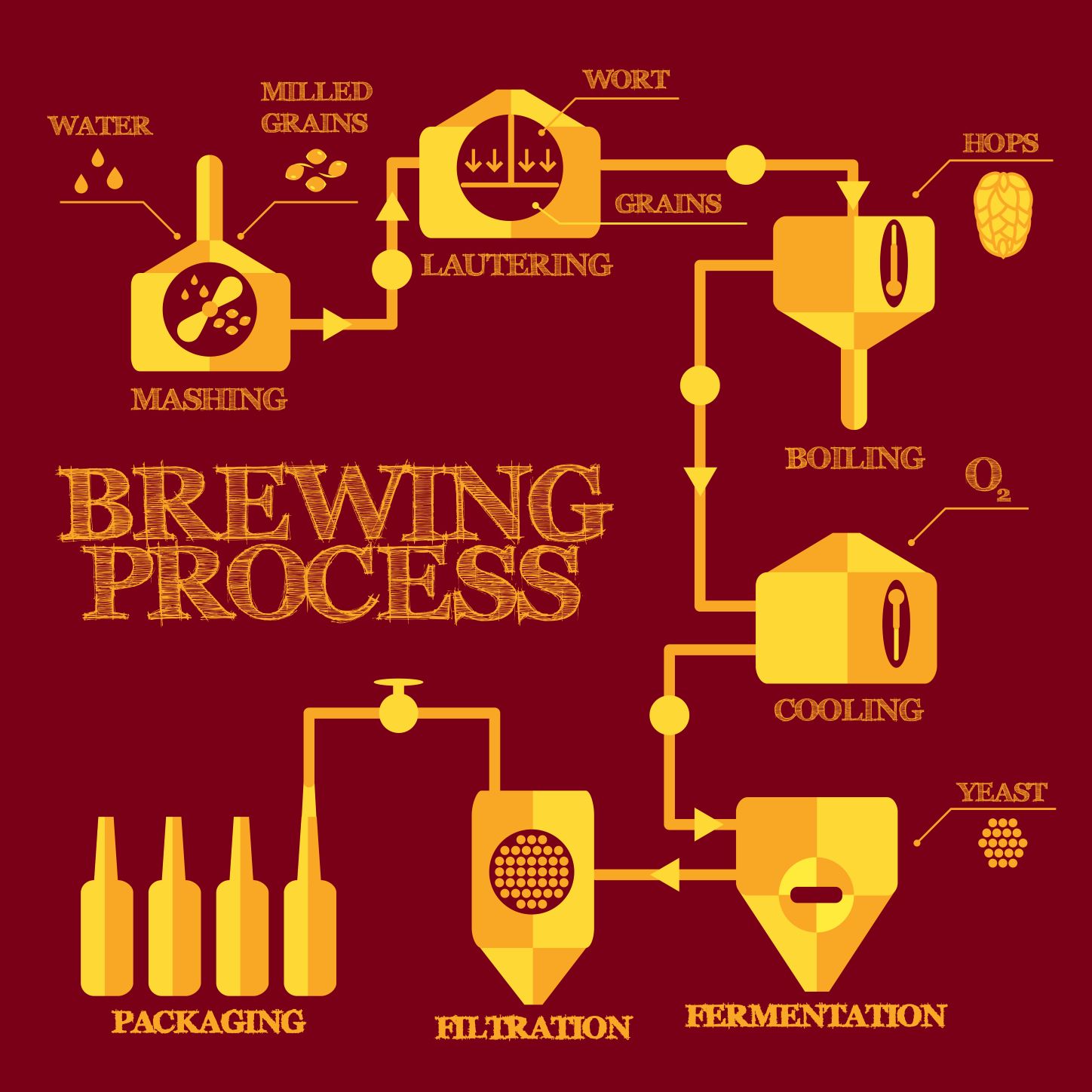Craft Brewing Process
Our knowledgeable brewery tour guides will give you a thorough walk through of the craft brewing process during your brewery tour.
The craft brewing process can be broken down into several key steps, which are milling, mashing, lautering, boiling, cooling, fermentation, conditioning, and packaging.
1.Milling: The milling process involves crushing or grinding the malted grains to create a fine powder known as grist. This is typically done using a specialized machine called a grain mill. The purpose of milling the grains is to break open the husks and expose the starchy interior of the grain, which contains enzymes that will later be activated during the mashing process.
The size of the grist particles can affect the efficiency of the brewing process, as well as the flavor and clarity of the finished beer. If the particles are too large, the wort may not extract enough sugars during mashing, resulting in a lower alcohol content and a weaker flavor. On the other hand, if the particles are too small, the wort may become cloudy and difficult to clarify. Therefore, it is important to achieve the optimal grist particle size for each batch of beer.
Milling can also impact the speed and consistency of the mashing process. By creating a uniform particle size, the enzymes in the grains will be activated more evenly, allowing for a more efficient conversion of starches to sugars. Additionally, milling the grains just before mashing can help to preserve the freshness and flavor of the malt.
2. Mashing: The mashing process is a critical step in the craft brewing process where the milled grains are mixed with hot water to extract the sugars from the grains. The main purpose of mashing is to activate the enzymes present in the malted grains, which convert the complex starches in the grains into simple sugars that will later be fermented by the yeast to produce alcohol.
The mashing process typically involves the following steps:
Dough-in: The milled grains are mixed with hot water in a vessel called a mash tun. The water-to-grain ratio and temperature are carefully controlled to achieve the desired sugar extraction and enzyme activity.
Mash rest: The mixture is then allowed to rest for a period of time to allow the enzymes to break down the starches into simple sugars. This is typically done in several steps, each at a different temperature, to optimize the activity of the different enzymes in the grains.
Mash-out: Once the desired sugar extraction has been achieved, the mixture is heated to a temperature around 170°F (77°C) in a process called mash-out. This helps to denature the enzymes and stop the conversion of starches to sugars.
3. Lautering: During lautering, the sweet, sugar-rich liquid called wort is separated from the spent grains, which have given up their flavors and sugars during mashing. The wort will be later boiled with hops to impart flavor, bitterness, and aroma before being fermented into beer.
The lautering process typically involves several steps:
Vorlauf: The first step in lautering is to recirculate the wort through the mash tun and the grain bed to filter out any solid particles and create a clear liquid. This is called vorlauf.
Sparging: Once the wort has been clarified, hot water is slowly added to the mash tun to rinse any remaining sugars from the spent grains. This process is called sparging. The hot water is added gently and slowly to avoid disturbing the grain bed.
Collecting: As the hot water is added, it mixes with the remaining sugars in the spent grains and creates more wort. The wort is then collected in a separate vessel called a brew kettle.
Lautering is a critical step in the craft brewing process that determines the quantity and quality of the wort. It requires careful control of the flow rate of the hot water and attention to the consistency of the grain bed to avoid channeling or clogging. The efficiency of lautering can also affect the final flavor, aroma, and clarity of the beer.
4. Boiling: The boiling phase of the brewing process is where the wort, which is the sugar-rich liquid extracted during mashing and lautering, is boiled with hops to create the desired flavor, bitterness, and aroma. Boiling also sterilizes the wort, removes unwanted compounds, and evaporates excess water to concentrate the sugars and other compounds in the wort.
The boiling process typically involves the following steps:
-Heating: The wort is transferred from the mash tun or lauter tun to a separate vessel called the brew kettle, which is heated to boiling temperature.
-Hops addition: Once the wort reaches boiling temperature, hops are added to the kettle. Hops contribute bitterness, flavor, and aroma to the beer, and their addition is typically timed to achieve the desired effect. The boiling process also helps to extract alpha acids from the hops, which contribute to the bitterness of the beer.
-Boiling time: The wort is boiled for a specific period of time, usually between 60 and 90 minutes, depending on the beer style and desired flavor profile. During boiling, excess water is evaporated, and unwanted compounds such as dimethyl sulfide (DMS) are removed.
-Whirlpooling: After the boiling process is complete, the wort is transferred to a separate vessel for whirlpooling. This helps to separate the hops and other solids from the liquid and create a clear wort.
The boiling step is critical for creating the desired flavor, aroma, and bitterness in the finished beer. The length of boiling, the timing of hops addition, and the amount of hops used can all affect the final product. Additionally, the boiling process helps to sterilize the wort, which is important for preventing bacterial contamination and ensuring a stable, high-quality beer.
5. Cooling: The cooling step in the beer brewing process is the stage where the wort (unfermented beer) is rapidly cooled down from boiling to a temperature suitable for yeast to be added. This step is important for several reasons:
-Preventing off-flavors: Rapidly cooling the wort helps prevent the growth of unwanted microorganisms, which can cause off-flavors and aromas in the finished beer.
-Promoting clarity: Cooling the wort also helps to promote clarity by causing proteins and other solids to precipitate out of the liquid.
-Preparing for fermentation: The cooled wort is then ready for the addition of yeast, which will ferment the sugars in the wort and create alcohol and carbon dioxide.
Typically, the wort is cooled down to around 20-25°C (68-77°F) before yeast is added. There are several methods for cooling the wort, including using a heat exchanger, immersion chiller, or simply letting it sit in a cool place for several hours.
6. Fermentation: The fermenting step is the stage where yeast is added to the cooled wort, and the yeast consumes the sugars in the wort and produces alcohol and carbon dioxide. This step is crucial to creating the unique flavor and aroma of beer.
During fermentation, the yeast consumes the fermentable sugars in the wort, producing alcohol and carbon dioxide as byproducts. The alcohol contributes to the beer’s flavor and gives it its characteristic “buzz,” while the carbon dioxide produces the carbonation that gives beer its characteristic fizz.
Fermentation typically takes place in a large vessel called a fermenter, which is usually made of stainless steel or plastic. The fermenter is sealed to prevent contamination from outside air, and the temperature is carefully controlled to ensure that the yeast produces the desired flavors and aromas.
The fermentation process can take anywhere from several days to several weeks, depending on the type of beer being brewed and the desired flavor and alcohol content.
6. Conditioning: Conditioning stage is when fermented beer is transferred to another vessel and allowed to mature and carbonate. This step is important to refine the flavors and carbonation of the beer, and it can take anywhere from a few days to several months.
During conditioning, the beer is usually transferred to a sealed vessel, such as a keg or bottle, and stored at a cool temperature. This allows the yeast to continue fermenting any remaining sugars and producing carbon dioxide, which naturally carbonates the beer.
Conditioning also allows the beer to mature and develop its flavors and aromas. During this time, any harsh or off-flavors produced during fermentation are smoothed out, and the beer takes on a more balanced and complex flavor profile.
The length of conditioning depends on the style of beer being brewed and the desired flavor and carbonation levels. Some beers, like lagers, may require longer conditioning times than ales. Once the beer has reached its desired flavor and carbonation, it is ready for packaging and consumption.
7. Packaging: Packaging is where the conditioned beer is bottled, canned, or kegged for distribution and consumption. This step is the final stage in the beer brewing process and is crucial to ensuring that the beer remains fresh and flavorful for as long as possible.
Packaging beer typically involves the use of specialized equipment, such as bottling or canning lines, that fill and seal containers with the beer. Kegging involves filling and sealing large stainless steel containers with beer, which are then transported to bars and restaurants for on-tap service.
Before packaging, the beer is usually filtered or pasteurized to remove any remaining yeast or bacteria and ensure that the beer remains stable over time. However, some craft breweries choose to leave their beer unfiltered and unpasteurized to preserve the natural flavors and aromas of the beer.


